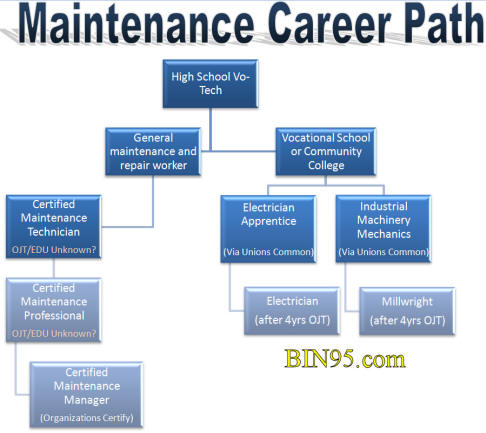What's an Industrial Maintenance Technician?
...and how do you become one? Should you?
Where on the promotion/career tree is an 'Industrial Maintenance Technician' Job?
According to the Occupational Outlook Handbook, a "maintenance and repair worker" is a 'Jack of All Trades, Master of None' (I am paraphrasing), building on High School Vo-Tech classes via OJT.
(Note since 2010 when this article was first written, the OOH descriptions have been updated to better reflect the actual 2018 job market, but still a catch-all. They have a "general maintenance" title now, and about $10k per year more title "Industrial Machinery Mechanics, Machinery Maintenance Workers, and Millwrights", which is closer to the actual "maintenance technician" job description.)

our industrial maintenance technician jobs chart
For advancement and definition of the 'maintenance and repair worker' and related occupations, the Occupational Outlook Handbook (OOH) references an educational institution that most USA high school students to Maintenance Managers have most likely never heard of titled "International Management Institute (IMI)". Probably because it is a school located in INDIA! The few Human Resource personnel who do the search and hiring for industrial maintenance personnel instead of the maintenance manager may have heard of IMI, but most likely did not get their education there. It is even more likely that whoever is doing the searching and hiring is not referencing IMI or even the OOH. They are just arbitrarily assigning one of the many job titles (Maintenance Worker, Maintenance Man, politically correct(Maintenance Person), Maintenance Technician, Maintenance Professional, Maintenance Electrician, Millwright, Electrician, PLC Technician, etc., etc.), and then assigning a custom skillset to that title they or someone else before them created.
The OOH goes on to indicate IMI's lowest level of certification is Certified Maintenance Technician, the second level is Certified Maintenance Professional, and the highest level of certification is Certified Maintenance Manager. So giving the world-renown IMI the credit and respect it is due, at least there is a clear career path set by them, if management in the USA knew, followed, or even cared about their occupational guidelines. But the real responsibility for lack of clarity, popularity (skill shortage), and uncertainty fall in the hands of the OOH and USA trade organizations. Because those two bodies have not established their own nationally recognized occupational guidelines, skill requirements, and titles. Like the Military and Unions have anyway.
In contrast, the career path for an Electrician, Millwright, or Machinist is clear, thanks to the Unions. They set the skill levels, training requirements, provide a path for training, on the job training (OJT), testing/certification, and annual re-certificate via continued education. Recognized nationwide, and by Federal and State local Governments, the license requires annual continued education, employers have a better sense of what skill sets they get when hiring. I am surprised the USA does not have a Nationally recognized Maintenance Union already as we do for the other trades.
Even US trade organizations blur the lines more by creating new occupational titles of their own, like "Certified Maintenance and Reliability Technician Program" which one trade organization defines as "industrial maintenance mechanics" and not an instrumentation technician or electrical technician. (But maybe a Reliability Technician, who knows. Other maintenance organizations have their own made-up titles for their certifications, making the career, training, and certification choices even more confusing, for everyone in the industry.
The path we could clearly outline for our High School students and USA industrial maintenance workers might be like the picture at the top of this article.
But in all my years of experience and in researching for this article, I still can't tell you how the hell to train for a Certified Industrial Maintenance Technician, or if that is really what an employer is looking for when they post a 'Maintenance' position. They may be looking for a Millwright who is also an Electrician that they can pay a Maintenance and Repair Worker's wages too. The more I research, the more unanswered questions arise ...
Are the qualifications to be a building "Maintenance Technician" the same as being an "Industrial Maintenance Technician"?
When an employer post a job opening for "Maintenance Technician II" how does one know if they are? It's not listed in the OOH.
Where do you get certified as a "Certified Maintenance Professional"? Where and what specific training do you need?
What is the difference between a "Certified Maintenance Technician" and a "Certified Maintenance Professional" and say a "Millwright", "Electrician", "Industrial Maintenance Mechanic"?
2018 update: See a job listing for "Industrial Electrician", the OOH is not going to list it. Luckily you can get a great sence of what is required by viewing the Industrial Electrical Training Video Course topics covered.
And the questions just keep coming...
One thing is for sure, knowing the above various job titles used by employers helps you when you are using our Industrial USA Jobs Search Engine.
Don Fitchett - Business Industrial Network (BIN) - BIN95.com
About the Author: Don Fitchett founded the activity-based costing system called "True Downtime Cost"™ (TDC), authored books and speaks at conventions on the topic and is president of BIN. Don has been in the industrial training sector for over two decades, setting up training programs around the world, and still conducts training seminars to this day.
Business Industrial Network delivers instructor based industrial training as well as software and on-line industrial training.
(You may copy and distribute this article as long as all credits, including this paragraph, are included and all links are active and distribution is not for profit. You may reference portions of this article as long as an active link back to the original article webpage at BIN95.com is present. Otherwise, this material is copyright protected.)
